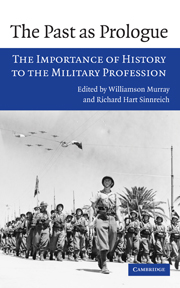Book contents
- Frontmatter
- Contents
- Contributors
- 1 Introduction
- 2 Military history and the history of war
- Part I The influence of history on the military profession
- Part II The past as illuminator of the future
- 7 Thucydides as educator
- 8 Clausewitz, history, and the future strategic world
- 9 History and the nature of strategy
- 10 Military transformation in long periods of peace: the Victorian Royal Navy
- 11 Military history and the pathology of lessons learned: the Russo-Japanese War, a case study
- 12 Obstacles to innovation and readiness: the British Army's experience, 1918–1939
- 13 What history suggests about terrorism and its future
- 14 History and future of civil–military relations: bridging the gaps
- Index
13 - What history suggests about terrorism and its future
Published online by Cambridge University Press: 05 June 2012
- Frontmatter
- Contents
- Contributors
- 1 Introduction
- 2 Military history and the history of war
- Part I The influence of history on the military profession
- Part II The past as illuminator of the future
- 7 Thucydides as educator
- 8 Clausewitz, history, and the future strategic world
- 9 History and the nature of strategy
- 10 Military transformation in long periods of peace: the Victorian Royal Navy
- 11 Military history and the pathology of lessons learned: the Russo-Japanese War, a case study
- 12 Obstacles to innovation and readiness: the British Army's experience, 1918–1939
- 13 What history suggests about terrorism and its future
- 14 History and future of civil–military relations: bridging the gaps
- Index
Summary
In late October 1954, an Algerian rebel military leader who helped initiate the coming revolution against French rule, Mostepha Ben Boulaid, gave detailed orders to a subordinate commander, Bachir Chihani. These included the usual tactics so commonly seen when guerrilla wars begin: sabotage phone lines, attack small military garrisons, and invade police depots to take weapons. But there was something else in those orders: ambush passing vehicles on the highways and kill any Moslem collaborator types found in them. The name for such Algerian persons, in this total war, was “Beni Oui Oui” – “yes men.” They were to die, not for taking action against the revolutionaries – because as yet there was no revolution – but merely for what they represented: comity among the mix of races, association with Europeans, and willingness to hold positions in the mixed political order controlled from Paris.
That directive was a first step in a war that would come to include many wrenching forms of “terrorism.” That word has been most usefully defined as “the deliberate and systematic murder, maiming, and menacing of the innocent to inspire fear for political ends.” What the Front de Libération Nationale (FLN) wanted, and used terrorism to advance, was polarization – social, political, and psychological. Few tools achieve it as readily as terrorism. The commander who wrote the orders of October 1954 understood that reality, although initially his victims might not have.
- Type
- Chapter
- Information
- The Past as PrologueThe Importance of History to the Military Profession, pp. 217 - 246Publisher: Cambridge University PressPrint publication year: 2006



